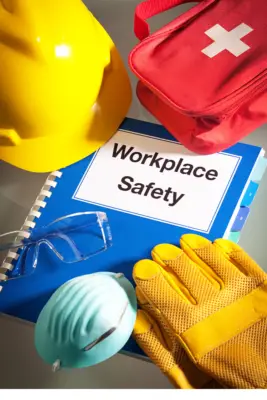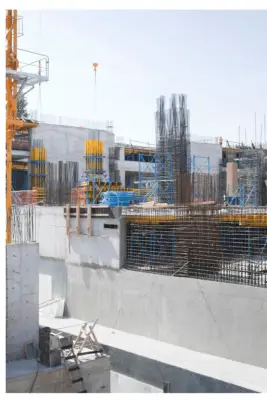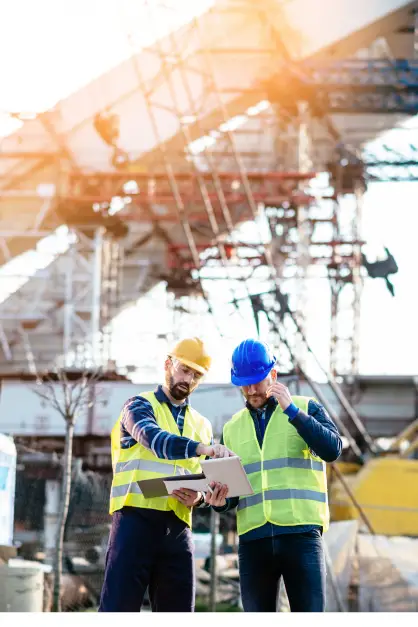Construction risks can be costly and dangerous for businesses. By understanding the types of risks and taking steps to mitigate them, you can protect your business from costly losses. Keeping your construction project on track and a budget can be a challenge. But with the proper risk assessment and mitigation plan in place, you can reduce the chances of costly delays or overruns.
Construction projects are risky, and it’s essential to be aware of the risks before starting a project. Many people don’t realize how risky construction projects can be. Mishaps can happen at any time, and they can have devastating consequences for the project’s success.
By understanding the most common risks and taking steps to mitigate them, you can significantly reduce the chances of something going wrong. Before starting a construction project, it’s vital to assess the risks. Doing so can help you identify potential risks and solve them before they become an issue.
Risks are identified with their mitigations through a risk register, to the least risk with no mitigations. Delays are a significant concern for every construction project. Delays can be costly and often result in missed deadlines.
This blog post will discuss some of the most common construction risks and ways to address them. We’ll also provide tips for assessing risk in your specific industry. Keep reading to learn more!
What is Risk in a Construction Project?
Risk in a construction project is the potential for loss that may occur during the project. It may be due to damage to property, injuries to people, or financial losses.
Risks can be classified as being either project risks or commercial risks. Project risk is specific to certain construction projects, such as the collapse of a newly constructed structure. Commercial risk affects all businesses regardless of their market, for example, an economic downturn that reduces the number of people who have money to spend on construction projects.
What are some typical causes of risk in a construction project?
There are many ways that risks can arise during any construction project, including late delivery of materials, injuries to site workers, design changes, and environmental factors such as changes in weather conditions.
All of these can affect the project schedule and budget. Another critical factor in construction risk is that whenever a contractor decides how to complete a task, there is always an element of uncertainty. One of the most significant sources of risk on construction projects is weather conditions if it rains when concrete is supposed to be poured; for example, the risk of the project being delayed increases.
Risks can be reduced by having a plan in place to deal with any issues swiftly and accurately. For example, if there is an injury on-site, the safety officer should call 999 immediately.
Risks in Construction Projects
When constructing a building, many risks can occur. For example, the workers might not know how to use the equipment safely or be adequately trained in using it. It can lead to injuries or even fatalities.
Another risk is that the workers might not complete the project on time or within budget. It can cause delays and increase the cost of the project. Additionally, if the wrong materials are used, or the construction isn’t done properly, the building may not be safe and could even collapse.
The project may also fail because the client changes their mind about the design. It can lead to costs and delays as new specifications. The company may be in legal trouble if it doesn’t ensure that the building meets local codes and regulations, resulting in lawsuits, fines, or both.
Insurance companies can respond to any risks by providing coverage for losses that occur due to the various risks. For example, an insurance policy might payout if the worker gets injured on the job or if a piece of equipment malfunctions and seriously injures someone.
A construction company should always protect itself by getting an insurance policy that includes all the risks involved in their industry and area. It is also essential for workers to be trained in the proper safety procedures before beginning any project.
How Do You Measure Construction Risk?
The most common way to measure construction risk is by using a risk matrix/risk register. A risk matrix is a table that lists all potential risks associated with a project and then rates each risk on a low, medium or high scale. It allows contractors and project managers to assess the level of risk associated with any given task or decision quickly.
The ratings can be determined by either a quantitative or qualitative method. Using a risk matrix, you can then determine four critical pieces of information that will allow you to understand the various risks associated with your project:
- Measure the probability that the risk will occur (low, medium, high) and its likelihood to impact the schedule in terms of time (i.e., finish early, start late).
- The type of impact that the risk will have on the schedule if it does occur (minor, significant, or significant/catastrophic), and an approximation of how much finished work will be impacted by the risk before being able to resume normal activities.
- How likely is the risk to affect the cost of the project.
- How much extra time does this risk leave you with before completing your project?
By aggregating all of these elements together, it becomes much easier to make more informed decisions about optimizing construction schedules. Suppose you know that a particular task or decision has a high probability that it will have a significant impact on your schedule. In that case, you will know that a particular task or decision should be approached with extra care.
On the other hand, if you have a risk that has a high impact in terms of cost but could have an early start date for its execution, then it may not be worth mitigating given its low probability.

Importance of Risk Management in Construction
Risk management is vital in construction because it helps identify potential hazards and prevent them from causing accidents or injuries. It also helps to ensure that projects are completed on time and within budget. Risk management importance includes:-
- Risk management is essential in construction because it helps identify potential hazards and minimize the risks of injuries or fatalities.
- By implementing a risk management plan, construction companies can save time and money by preventing or reducing incidents that lead to costly delays and litigation.
- Risk management also promotes safety in the workplace and can help to improve communication among workers.
- Effective risk management requires careful planning, coordination, and execution, but the benefits are worth the effort.
Challenges of Risk Management in Construction
Managing construction risks is a challenging task that requires expertise in risk assessment, planning, and execution. By implementing a risk management plan, construction professionals can mitigate or avoid many risks altogether. Challenges include;-
- The complexity of the construction industry is due to numerous stakeholders, differing goals, and constantly changing project conditions.
It is exacerbated by the fact that no two projects are exactly alike. There are too many unique factors to account for, including but not limited to;- The inherent challenges in managing risks can cause increased costs and project delays.
Traditionally, taking on risk has been considered an integral part of the contract. It has resulted in unmanageable risks that the construction companies are not prepared to handle. A healthy risk management strategy is required to mitigate these risks and ensure that cost overruns are kept at bay while still meeting project deadlines.
- Evolving risks and a lack of dedicated risk management professionals in the industry lead to suboptimal risk management practices.
- Construction companies often lack protocols for identifying, assessing, and responding to risks, leading to safety issues and costly delays.
- A fragmented insurance market with many insurers offering limited coverages leads to increased premiums and difficulty securing adequate insurance protection.
- Lack of standardization or centralized data repository hampers efficient information sharing among project stakeholders.
- Construction projects are often large and expensive, so there is a lot at stake if something goes wrong.
- The risks associated with construction can be challenging to assess and manage accurately.
- The preliminary and constantly-evolving design of a construction project creates unique challenges for risk management.
- Projects are often plagued by cost overruns and schedule delays, creating new risks for the project team.
- Contractors and subcontractors can be challenging to manage, and they may not always adhere to safety protocols or contractual deadlines.
- Natural disasters (e.g., hurricanes, earthquakes) can create unforeseen risks that must be managed quickly and effectively.
How Do you Control Construction Industry Risks?
The best way to control construction industry risks is by implementing safety measures. You can also control construction industry risks by having a solid insurance policy. You will need to develop a plan that can help you cope with all construction industry risks.
The following are ways of controlling risks in the construction industry:-
- Implementing and following best safety practices in the workplace can significantly reduce the risk of accidents, injuries, and fatalities in the construction industry.
- Having an effective safety program in place can also help to protect workers from joint injuries, such as slips, trips, and falls.
- Keeping workspaces clean and organized can also help to prevent accidents.
- Wearing the proper safety equipment can help protect workers from potential hazards on the job site.
- Training employees on safely working in a construction environment is essential for minimizing risks.
Assessing Risks in Construction Industry
Risks in the construction industry need to be assessed regularly to protect workers, property, and the public. Threats in the construction industry can be weather, falling objects, and hazardous materials.
The threat of falling objects is especially prevalent when working at heights. Risks in this industry do not end with falling. Workers may also be subject to chemical burns light injuries such as cuts and lacerations. Electrical hazards such as shock or electrocution and musculoskeletal injuries such as sprains or strains.
Construction workers are known for their high injury rates. In the United States, the Bureau of Labor Statistics reports that over 560 construction industry workers die annually in work-related accidents. Employment amounts to 5% of the overall economy (in 2019).
There are many ways to assess the risk of potential dangers, including:-
- Assess the feasibility of the construction project by studying blueprints and gathering information about the site.
- Consider potential risks to workers, such as falls, electrocution, and exposure to hazardous materials.
- Conduct a pre-job safety meeting to discuss hazards specific to the project.
- Inspect the worksite for potential hazards before beginning work.
- Evaluate the risks posed to the public by analyzing traffic patterns and potential hazards to pedestrians.
- Predict weather conditions that could affect the project schedule or safety, such as high winds, lightning, and heavy rain or snowfall.
- Review safety protocols and emergency response plans in case of accidents or emergencies.
- Always check the contractor’s license and insurance.
- Ensure the contractor has a safety plan in place and that you understand it.
- Get several quotes before selecting a contractor, and ensure they are all from reputable companies.
- Check online review sites to see if other customers have had good experiences with the contractor.
- Assess risks in construction. It’s essential to be familiar with common hazards and how to mitigate them.”

Mitigating Risks in Construction Industry
Mitigating risks in the construction industry is a critical part of ensuring the safety of workers and the public. By taking proactive steps to identify and address potential hazards, construction companies can minimize the chances of an accident or injury. Some of the most common risk mitigation strategies include:
- Training employees on how to safely work in potentially hazardous areas.
- Identifying and addressing potential hazards before work begins.
- Implementing safety protocols and procedures.
- Regularly inspect worksites for potential dangers.
- Providing adequate safety gear and equipment(PPE) to workers.
- Ensure all employees are adequately trained and certified in their trade.
- Create and enforce a safety protocol, including proper use of safety equipment.
- Inspect equipment and tools before use; replace or repair as necessary.
- Establish a system for reporting any potential hazards or accidents.
- Conduct regular safety meetings to review safety protocol and identify potential risks.
Construction companies need to be aware of the risks associated with their industry and take steps to mitigate those risks as much as possible. By doing so, they can help ensure the safety of their employees and the general public.
Conclusion
Construction risks can be mitigated by careful planning and execution, as well as a good understanding of what can go wrong. Construction managers can save time, money, and time by assessing potential risks before they become problems.
Risks can be reduced through contingency planning, including setting up fail-safes and forming robust mitigation strategies. ‘Networks’ of diversified team members, allowing for maximum problem-solving potential. Knowing the limits of all parties involved is important to ensure that risks are kept to a minimum. Understanding that not all risks can be mitigated and knowing how to deal with failure when it does happen is critical to ensuring that the construction phase of a project goes smoothly.
Risk management is an important part of any construction project; it should not be taken lightly. Have you ever encountered a risk while working on a construction project? How did you mitigate the risk? Let us know in the comments.

Chris Ekai is a Risk Management expert with over 10 years of experience in the field. He has a Master’s(MSc) degree in Risk Management from University of Portsmouth and is a CPA and Finance professional. He currently works as a Content Manager at Risk Publishing, writing about Enterprise Risk Management, Business Continuity Management and Project Management.

